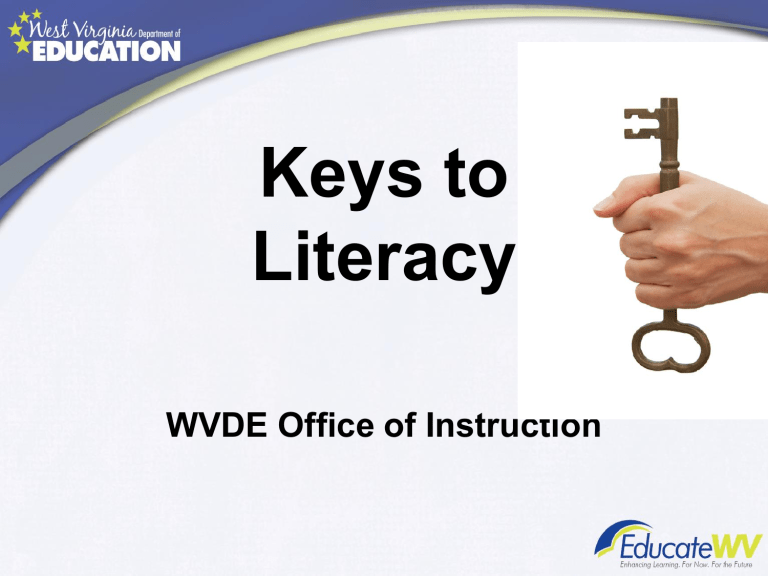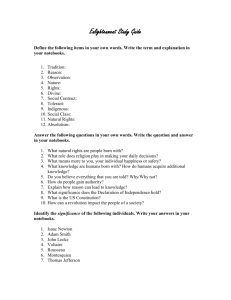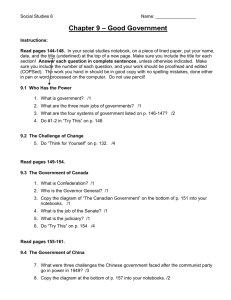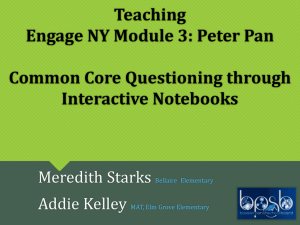Keys to Literacy WVDE Office of Instruction

Keys to
Literacy
WVDE Office of Instruction
Review of Homework
For each of the Keys to Literacy below, please bring evidence/artifacts of how it was used in your classroom/school.
• Activating Prior Knowledge
• Building Vocabulary
• Modeling the Processes
• Encouraging Classroom Discourse
• Drawing Conclusions Based on Evidence
Report Out
Key Shifts
• Building knowledge through content-rich nonfiction
• Reading, writing and speaking grounded in
evidence from text, both literary and informational
• Regular practice with complex text and its academic language
Building knowledge through content-rich nonfiction
• 70% Informational/30% Literary throughout the school day
• 25% Informational/75% Literary in English class
• Activating prior knowledge without telling students everything they need to know
Reading, writing and speaking grounded in
evidence from text, both literary and informational
• Text-Dependent Questions
• Argumentative Writing based on textual information
Evidence from Text
•
Most college and workplace writing requires evidence.
•
Ability to cite evidence differentiates strong from weak student performance on NAEP
•
Evidence is a major emphasis of the ELA Standards: Reading
Standard 1, Writing Standard 9, Speaking and Listening standards 2, 3 and 4, all focus on the gathering, evaluating and presenting of evidence from text.
•
Being able to locate and deploy evidence are hallmarks of strong readers and writers
7
Not Text-Dependent
•
In “Casey at the Bat,” Casey strikes out.
Describe a time when you failed at something.
•
In “Letter from a Birmingham Jail,” Dr.
King discusses nonviolent protest.
Discuss, in writing, a time when you wanted to fight against something that you felt was unfair.
•
In “The Gettysburg Address” Lincoln says the nation is dedicated to the proposition that all men are created equal. Why is equality an important
8 value to promote?
Text Dependent
Questions
Text-Dependent
What makes Casey’s experiences at bat humorous?
What can you infer from King’s letter about the letter that he received?
“The Gettysburg Address” mentions the year 1776. According to Lincoln’s speech, why is this year significant to the events described in the speech?
Valuable Strategy
• Annotating the Text
– Underline important terms.
– Circle definitions and meanings.
– Write key words and definitions in the margin.
– Signal where important information can be found with key words or symbols in the margin.
– Write short summaries in the margin at the end of subunits.
– Write the questions in the margin next to the section where the answer is found.
– Indicate steps in a process by using numbers in the margin.
Sample ELA Item
Click on two phrases from the paragraph that help you understand the meaning of scarred.
Sample ELA Item
Select three sentences that show that Naomi is worried she has done something wrong.
Regular practice with complex text and its academic language
• Instruction on grade level text
• Intentional focus on vocabulary
Vocabulary Research
• Vocabulary knowledge is one of the best indicators of verbal ability.
• Vocabulary difficulty strongly influences the readability of text.
• Teaching vocabulary of a selection can improve students’ comprehension of that selection.
Some Vocabulary Practices…
Research-based Practices
Use teacher directed, explicit instruction
Provide opportunities to practice using words
Teach word meanings explicitly and systematically
Teach independent word learning strategies (i.e., contextual strategies & morphemic analysis)
When we do not instruct students using appropriately complex text (grade level), we limit their exposure to complex vocabulary, intricate sentence structure, and we create a knowledge gap that will affect future comprehension.
Analyzing Documents
Primary and
Secondary
Sources
Consider
See - Think - Wonder
Observe - Reflect - Question
Library of Congress
• Teacher's Guides and Analysis Tool
• Observe – Reflect- Question
• http://www.loc.gov/teachers/usingprimaryso urces/guides.html
• Write your name on your journal.
• Label the first page “Table of Contents”.
• Number each page.
• On the last page, create an Alpha Box graphic organizer.
Debrief Notebook Task
Purpose of Notebook
• To record new understandings
• To pose questions to which you need to find the answers
• To record “Ah Ha’s”
• To explore new concepts
• To provide a record of your experiences
Content for Notebooks
• Entries that help develop conceptual understanding and critical thinking within the context of their investigations
• Write about only the concepts and thinking involved
• Talk about the class experiences among themselves—turn and talk
• In science don’t have students write procedures
• Never score notebooks have students use them
Notebooks are Rough
Drafts
• Focus on
– Content –concepts and thinking
– Organization (critical thinking and skills)
– Word choice (vocabulary)
– Legibility ( readable)
Motivation
• Engaging students in all subject areas
• Discovery
• Inquiry
Four components of teaching and learning of science
• Science Content
• Scientific thinking
• Scientific skills
• Expository writing
Writing in Science
• Students are motivated to learn from being engaged in meaningful learning experiences
• Understanding science concepts to think scientifically
• Science notebooks serves as tools in learning
• Students need scaffolding and modeling
• Entries should focus on expository writing
Scaffolding
• Structured support
– Word banks
– Graphic organizers
• Tables
• Graphs
• Flow maps
• diagrams
– Writing frames---for students
Scaffolding
• Charts
• Word banks
• Graphic organizers
• Model and provide sentence starter
• Provide less scaffolding over time
Let’s do some science
• Get with a partner
• Notebooks
• Writing utensil
Observations/ Illustration
• Characteristics: Size, shape, color, lines, patterns, texture, odor, behavior
• I wonder
• Note any changes
Describe:
Illustration: Label , Title, Accurate
Observation Frame
• I observed….
• I noticed……
• It reminds me of ……because….
• When …….it ……
• At first ……but now….
• It surprised me that…because…
Observations Organizer
Writing Frame
Think of properties you can see such as, size, shape, color, lines, texture, pattern, behavior
I observed
Think of the other senses of smell, sound, touch, and perhaps taste!
I noticed
Connect it with something that you already know
It reminds me of
Add more details as needed This is so because
Be curious and ask questions you could investigate
I am curious about
It surprised me that
I wonder what would happen if
This organizer or writing frame is one part of a comprehensive, research-based approach to teaching students how to think, talk and write like scientists. (See Writing in Science by Betsy Rupp Fulwiler, © 2007, Portsmouth, NH: Heinemann.)
Similarities
THE BOX & T-CHART
Differences
This organizer or writing frame is one part of a comprehensive, research-based approach to teaching students how to think, talk and write like scientists. (See Writing in Science by Betsy Rupp Fulwiler, © 2007, Portsmouth, NH: Heinemann.)
COMPARE AND CONTRAST
Writing Frame
Start with how things are the same or similar.
The _____ and the ______ are the same because they both
___________.
Add more details as needed.
Explain how they are different. You can compare the same property or characteristic in the same sentence. Use
“and”, “but”, or
“whereas” to set up the contrast.
In addition, they both
________________.
They are different because the
______, but the ______ does not.
Add more detail as needed.
Also, the ________, whereas the
________________ does not.
This organizer or writing frame is one part of a comprehensive, research-based approach to teaching students how to think, talk and write like scientists. (See Writing in Science by Betsy Rupp Fulwiler, © 2007, Portsmouth, NH: Heinemann.)
Video
• What is the teacher doing
• What are the students doing
Discussion
From the video lets table talk
• What was the teacher doing
• What were the students doing
Effective Questioning
• Can you tell me about…..?
• What else would you tell another scientist?
• How do you know?
• What did you observe?
• Because……?
• If another scientist looked at your data table, what would she need to know?
Feedback to students
• Provide constructive, positive feedback
• For Notebook entries
• Start with strengths, then address weakness by posing questions scientist would ask
• Formal and informal ways need to be developed
What can you do ?
• Table talk….
• Table talk



